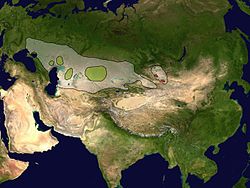 The saiga (Saiga tatarica) is a Critically Endangered antelope which originally inhabited a vast area of the Eurasian steppe zone from the foothills of the Carpathians and Caucasus into Dzungaria and Mongolia. They also lived in North America during the Pleistocene. Today the nominate subspecies (Saiga tatarica tatarica)
is only found in one location in Russia (steppes of the North-West
Precaspian region) and three areas in Kazakhstan (the Ural, Ustiurt and
Betpak-dala populations). A proportion of the Ustiurt population
migrates south to Uzbekistan and occasionally Turkmenistan in winter. It
is extinct in China and southwestern Mongolia. The Mongolian subspecies
(Saiga tatarica mongolica) is found only in western Mongolia.
The saiga (Saiga tatarica) is a Critically Endangered antelope which originally inhabited a vast area of the Eurasian steppe zone from the foothills of the Carpathians and Caucasus into Dzungaria and Mongolia. They also lived in North America during the Pleistocene. Today the nominate subspecies (Saiga tatarica tatarica)
is only found in one location in Russia (steppes of the North-West
Precaspian region) and three areas in Kazakhstan (the Ural, Ustiurt and
Betpak-dala populations). A proportion of the Ustiurt population
migrates south to Uzbekistan and occasionally Turkmenistan in winter. It
is extinct in China and southwestern Mongolia. The Mongolian subspecies
(Saiga tatarica mongolica) is found only in western Mongolia.Physical characteristics
Habitat and behavior
Saigas form very large herds that graze in semi-desert steppes eating several species of plants, including some that are poisonous to other animals. They can cover considerable distances and swim across rivers, but they avoid steep or rugged areas. The mating season starts in November, when stags fight for the possession of females. The winner leads a herd of 5-50 females. In springtime the mother gives birth to, in two thirds of all cases two, or in one third, one single foal.
Distribution

Stuffed saiga herd at The Museum of Zoology, St. Petersburg

Reconstructed range (white) and current distribution of the two subspecies Saiga tatarica tatarica (green) and Saiga tatarica mongolica (red)
Its population fell drastically following the collapse of the Soviet Union, due to uncontrolled hunting and demand for its horns in Chinese medicine. At one point, some conservation groups, such as the World Wildlife Fund, encouraged the hunting of this species as its horn was presented as an alternative to that of a rhinoceros.
Today the populations have again shrunk enormously, as much as 95% in 15 years, and the saiga is classified as critically endangered by the IUCN. There is an estimated total number of 50,000 saigas today, which live in Kalmykia, three areas of Kazakhstan and in two isolated areas of Mongolia. Another small population in the Pre-Caspian region of Russia, remains under extreme threat.
Cherny Zemli Nature Reserve was created in Russia's Kalmykia Republic in 1990s to protect the local saiga population and the President of Russia's Kalmykia Republic, Kirsan Ilyumzhinov, announced year of 2010 in Kalmykia as Year of Saiga. In Kazakhstan, the number of saiga was recently found to be increasing, from around 21,000 at the begin of this millennium to around 81,000 in January 2010.
However, in May 2010, it was announced that an estimated 12,000 of the 26,000 Saiga population in the Ural region of Kazakhstan have been found dead. Although the deaths are currently being ascribed to pasteurellosis, an infectious disease that strikes the lungs and intestines, the underlying trigger remains to be identified.
Kazakhstan in November 2010 reaffirmed a ban on hunting saiga antelopes, and extended this ban until 2021, as the Central Asian nation seeks to save the endangered species.
The Mongolian saiga (Saiga tatarica mongolica) is found in a small area in western Mongolia around Sharga and Mankhan Nature Reserve.
Currently only the Moscow Zoo zoo and Askania-Nova keep saigas. Cologne and San Diego Zoos had them in the past. Pleistocene Park in northern Siberia plans to introduce the species.
Conservation
The Saiga Conservation Alliance was started back in the early 1990s as an informal network of researchers and conservationists to study and protect the critically endangered saiga antelope. The SCA was officially inaugurated in September 2006, and in November 2006 was granted Candidate Partner status by the Wildlife Conservation Network. SCA also publishes a quarterly newsletter with latest updates from the field and range countries.
The organization Rewilding Europe has plans for reintroducing saiga to Europe.
Among followers of traditional Chinese medicine, saiga horns can be sold for as much as $150.
No comments:
Post a Comment